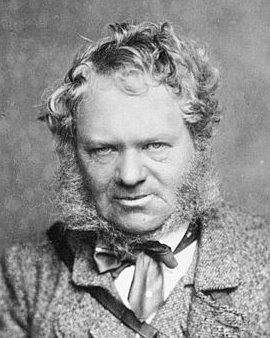Sir Edwin Landseer (1802 - 1873) was born as the youngest of three sons of the British engraver John Landseer. While his brother Thomas Landseer also became a copper engraver and his other brother Charles Landseer devoted himself to history painting, Edwin's works showed, apart from portraits, mainly nature and animal motifs. He first received his first lessons from his father. Later he studied with various other painters, most notably the history painter Benjamin Robert Haydon. This encouraged him to make animal preparations. In this way he should become familiar with the anatomy of animals. This true-to-detail and three-dimensional representation was later to be seen in many of his works. Landseer was considered a child prodigy. He already had his first own exhibition at the Royal Academy at the age of 13. He travelled to Scotland for the first time in his early 20s. He fell in love not only with the wild nature of the Highlands, but also with the almost 20 years older Duchess of Bedford, Georgina Russell. Despite the great age difference, the two had an affair.
Many of Edwin Landseer's later works were influenced by the nature of Scotland. So also one of his most famous works "The Monarch of The Glen". The picture of the majestic stag, is still one of the most popular works in British art. His animal motifs and depictions of nature made Edwin Landseer the favourite painter of Queen Victoria, who knighted him in 1850. Besides nature motifs, Edwin Landseer painted mainly dogs. Many rich and noble Britons had their pets portrayed by him. Especially often he painted a black and white version of the Newfoundland Dog, then known as Newfoundland Dog. Later it was renamed Landseer in his honour. "A Distinguished Member of the Humane Society" is one of his most famous depictions of this dog breed.
Around 1840, in his late 30s, Edwin Landseer suffered a severe nervous breakdown from which he never recovered. The rest of his life was marked by depression, alcohol and drug abuse. Therefore he refused the position as president of the Royal Academy, which was offered to him in 1866. With increasing age, Landseer's mental health continued to deteriorate. So his family had to have him declared insane in 1872. But Landseer was not prevented from painting until the end of his life.
×





.jpg)
.jpg)
.jpg)
.jpg)
.jpg)
.jpg)
.jpg)
.jpg)
.jpg)
.jpg)
 - (MeisterDrucke-211983).jpg)
 - (MeisterDrucke-211983).jpg)
.jpg)
.jpg)
.jpg)
.jpg)
_-_(MeisterDrucke-1090258).jpg)
_-_(MeisterDrucke-1090258).jpg)
 - (MeisterDrucke-186734).jpg)
 - (MeisterDrucke-186734).jpg)
.jpg)
.jpg)
_-_(MeisterDrucke-892701).jpg)
_-_(MeisterDrucke-892701).jpg)
.jpg)
.jpg)
.jpg)
.jpg)
.jpg)
.jpg)
_-_(MeisterDrucke-187835).jpg)
_-_(MeisterDrucke-187835).jpg)
.jpg)
.jpg)
.jpg)
.jpg)
.jpg)
.jpg)
.jpg)
.jpg)
.jpg)
.jpg)
_-_(MeisterDrucke-1644240).jpg)
_-_(MeisterDrucke-1644240).jpg)
.jpg)
.jpg)
.jpg)
.jpg)
.jpg)
.jpg)
.jpg)
.jpg)
.jpg)
.jpg)
.jpg)
.jpg)
.jpg)
.jpg)
.jpg)
.jpg)
.jpg)
.jpg)
.jpg)
.jpg)
_-_(MeisterDrucke-93781).jpg)
_-_(MeisterDrucke-93781).jpg)
.jpg)
.jpg)
_-_(MeisterDrucke-572100).jpg)
_-_(MeisterDrucke-572100).jpg)
_-_(MeisterDrucke-1099862).jpg)
_-_(MeisterDrucke-1099862).jpg)
.jpg)
.jpg)
_(see_a_-_(MeisterDrucke-89511).jpg)
_(see_a_-_(MeisterDrucke-89511).jpg)
.jpg)
.jpg)
.jpg)
.jpg)
.jpg)
.jpg)
_-_(MeisterDrucke-1315624).jpg)
_-_(MeisterDrucke-1315624).jpg)
.jpg)
.jpg)
.jpg)
.jpg)
.jpg)
.jpg)
_-_(MeisterDrucke-1457901).jpg)
_-_(MeisterDrucke-1457901).jpg)
.jpg)
.jpg)
_-_(MeisterDrucke-1128200).jpg)
_-_(MeisterDrucke-1128200).jpg)
.jpg)
.jpg)
.jpg)
.jpg)
.jpg)
.jpg)
.jpg)
.jpg)
 daughter of Georgina the - (MeisterDrucke-662351).jpg)
 daughter of Georgina the - (MeisterDrucke-662351).jpg)
.jpg)
.jpg)
.jpg)
.jpg)
.jpg)
.jpg)
_c1821_(pencil_und_wc_on_paper)_-_(MeisterDrucke-325526).jpg)
_c1821_(pencil_und_wc_on_paper)_-_(MeisterDrucke-325526).jpg)
.jpg)
.jpg)
.jpg)
.jpg)
.jpg)
.jpg)
.jpg)
.jpg)
.jpg)
.jpg)
.jpg)
.jpg)
.jpg)
.jpg)
_-_(MeisterDrucke-1458003).jpg)
_-_(MeisterDrucke-1458003).jpg)
.jpg)
.jpg)
.jpg)
.jpg)
.jpg)
.jpg)
.jpg)
.jpg)
.jpg)
.jpg)
.jpg)
.jpg)
.jpg)
.jpg)
_-_(MeisterDrucke-1122797).jpg)
_-_(MeisterDrucke-1122797).jpg)
.jpg)
.jpg)
_(oil_on_panel)_-_(MeisterDrucke-1457884).jpg)
_(oil_on_panel)_-_(MeisterDrucke-1457884).jpg)
.jpg)
.jpg)
.jpg)
.jpg)
.jpg)
.jpg)
_-_(MeisterDrucke-72547).jpg)
_-_(MeisterDrucke-72547).jpg)
.jpg)
.jpg)
.jpg)
.jpg)
_-_(MeisterDrucke-1425132).jpg)
_-_(MeisterDrucke-1425132).jpg)
_-_(MeisterDrucke-1127886).jpg)
_-_(MeisterDrucke-1127886).jpg)
.jpg)
.jpg)
.jpg)
.jpg)
.jpg)
.jpg)
.jpg)
.jpg)
.jpg)
.jpg)
.jpg)
.jpg)
_-_(MeisterDrucke-1461612).jpg)
_-_(MeisterDrucke-1461612).jpg)
.jpg)
.jpg)
 - (MeisterDrucke-187997).jpg)
 - (MeisterDrucke-187997).jpg)
 as a Child in t - (MeisterDrucke-269243).jpg)
 as a Child in t - (MeisterDrucke-269243).jpg)
.jpg)
.jpg)
_-_(MeisterDrucke-109719).jpg)
_-_(MeisterDrucke-109719).jpg)
.jpg)
.jpg)
.jpg)
.jpg)
.jpg)
.jpg)
_(oil_on_panel)_-_(MeisterDrucke-1457900).jpg)
_(oil_on_panel)_-_(MeisterDrucke-1457900).jpg)
.jpg)
.jpg)






